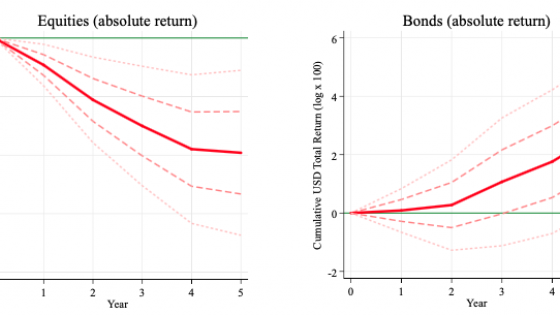The transition from one’s carefree youth to adulthood and middle age is often marked by the loss of a parent. The field of modern finance reached this milestone on 22 June 2023 with the passing of Harry Max Markowitz.
As one of the founding fathers of the field, few scholars have left as enduring a legacy. Through his pioneering formulation of investing as a mean-variance portfolio optimisation problem, Markowitz profoundly reshaped the theory and practice of finance. His work laid the firmest of foundations on which the entire edifice of asset management, risk management, performance attribution and much of corporate finance is built.
In fact, the enormity of his impact can be gauged by the simple fact that most finance experts place the dividing line between classical and modern finance at 1952, the publication year of Markowitz’s article “Portfolio Selection” in the Journal of Finance.
This piece served as the genesis of modern portfolio theory (MPT), which forever altered how investors think about risk and return in a portfolio context. MPT, at its core, suggests that investing should be less about picking winners – a common pastime among armchair investors – and more about a disciplined approach to managing one’s savings.
This dramatic departure from a focus on individual companies to a bird’s-eye view of the entire landscape of investment opportunities was as radical as it was systematic, a cut-and-dried exercise in quadratic optimisation that left no doubt as to how much to hold in each asset among the total universe of investable securities. It also left no room for the ‘gunslinger’ portfolio manager, a departure from the Wall Street culture of the 1960s and 1970s.
The beauty of MPT was not just the mathematical rigor with which it was constructed (‘rigor’ is often accompanied by ‘mortis’), but also the fact that its logic was both impeccable and understandable. For example, Markowitz introduced the concept of the efficient frontier – a collection of portfolios that offer the highest expected return for a given level of risk – and it could easily be explained by a simple two-dimensional graph.
This concept marked the birth of the risk/reward trade-off, a fundamental principle that underpins much of contemporary finance. Investors, for the first time, could scientifically assess their portfolios' performance, balancing their appetite for risk against their desire for investment return.
Markowitz elaborated on these ideas in his 1959 book, Portfolio Selection: Efficient Diversification of Investments, emphasising the concept of diversification, often called ‘the only free lunch in financial markets’.
One of the most important implications of MPT is that a well-diversified portfolio can help reduce risk without necessarily compromising on expected returns. His argument rested on the obvious but surprisingly subtle idea that asset prices do not always move in perfect unison, implying that losses from one asset can potentially be offset by gains from another.
Some sceptics have attempted to trivialise this important insight by claiming that we already knew not to ‘put all our eggs in one basket’. But Markowitz taught us how to distribute the eggs among a specific number of baskets and how to change that distribution as the eggs changed their risk/reward profiles.
Yet another testament to Markowitz's foundational role in financial economics is his influence on the capital asset pricing model (CAPM). While the CAPM was developed by William Sharpe, Jack Treynor, John Lintner and Jan Mossin, it clearly builds on Markowitz's MPT, linking an investment's expected return to its systematic risk, known as beta. This further solidified the risk-return relationship in investment decision-making, underscoring the importance of Markowitz's initial groundwork.
In fact, Markowitz had a direct impact on Sharpe’s career path when the two overlapped briefly at the RAND Corporation in the late 1950s. Sharpe explained that “… I introduced myself to Harry, and we chatted for an extended period of time. And basically, Fred Weston, Armen Alchian, on the faculty at UCLA, made a deal that Harry would in effect be my dissertation adviser, although he was not on the faculty. So, Harry was very much a big influence.” (Lo and Foerster 2023: 56).
In 1961, Sharpe completed his PhD dissertation, “Portfolio Analysis Based on a Simplified Model of the Relationships Among Securities”. Three years later, Sharpe published his CAPM paper (Sharpe 1964) for which he would win the Nobel Prize in Economics in 1990, shared fittingly with Markowitz and Merton Miller. The Nobel Committee commended Markowitz for laying the groundwork for the theory of financial economics and transforming portfolio theory into an empirical science.
Markowitz's work also had a direct, profound impact on how financial institutions and individuals manage investments. His theories underpin strategies employed by pension funds, mutual funds and individual investors worldwide. Furthermore, the advent of robo-advisors – automated digital platforms offering personalised investment advice – relies on MPT to optimise investor portfolios.
Markowitz's theories have transcended academia and seeped into the regulatory fabric. The Basel Accords, which provide regulatory oversight to banks' capital adequacy, employ the value-at-risk (VaR) concept – a risk measure inspired by Markowitz's work. VaR is used extensively by banks, financial regulators and investment companies for risk management and financial reporting purposes.
MPT has also been applied to fields outside of finance, including my own work on financing drug development and fusion energy (Bisias et al. 2012, Fernandez et al. 2012, Fagnan et al. 2015, Lo and Thakor 2022, Alhamdan et al. 2023).
But like all theories, Markowitz's work is not without its critics. Some argue that MPT relies on assumptions that are often violated in reality, such as rational investors and normally distributed asset returns. Despite these criticisms, Markowitz's contributions have stood the test of time, providing a valuable theoretical framework for understanding and navigating financial markets.
Harry Markowitz's monumental contributions to modern finance have deeply influenced both academia and practice. His work on portfolio selection and risk management paved the way for a more sophisticated understanding of financial markets. Despite certain limitations, his theories continue to be integral to financial modelling and decision-making processes.
Over seven decades later, Markowitz's influence remains indelible, making him one of the founding fathers of modern finance. His contributions underscore the significant impact that thoughtful, innovative thinking can have on shaping our understanding of complex systems like financial markets.
References
Alhamdan, A, Z M Halem, I Hernandez, A W Lo, M Singh and D Whyte (2023), “Financing Fusion Energy”, Journal of Investment Management 21(1): 5-51.
Bisias, D, A W Lo and J F Watkins (2012), “Estimating the NIH Efficient Frontier”, PLoS ONE 7(5): e34569.
Fagnan, D E, N N Yang, J C McKew and A W Lo (2015), “Financing Translation: Analysis of the NCATS Rare-Diseases Portfolio”, Science Translational Medicine 7(276): 276ps3.
Fernandez, J-M, R M Stein and A W Lo (2012), “Commercializing Biomedical Research through Securitization Techniques”, Nature Biotechnology 30(10): 964-75.
Lo, A W, and S R Foerster (2021), In Pursuit of the Perfect Portfolio: The Stories, Voices, and Key Insights of the Pioneers Who Shaped the Way We Invest, Princeton University Press.
Lo, A W, and R T Thakor (2022), “Financing Biomedical Innovation”, Annual Review of Financial Economics14: 231-70.
Markowitz, H M (1952), “Portfolio Selection”, Journal of Finance 7: 77-91.
Markowitz, H M (1959), Portfolio Selection: Efficient Diversification of Investments, Monograph 16, Cowles Foundation for Research in Economics, Yale University.
Sharpe, W F (1961), "Portfolio Analysis Based on a Simplified Model of the Relationships Among Securities", PhD Dissertation, University of California at Los Angeles.
Sharpe, W F (1964), “Capital Asset Prices: A Theory of Equilibrium Under Conditions of Market Risk”, Journal of Finance 19: 425-42.



